- Accueil
- Pages cachées
- 10 MARS 2024 NEWS
10 MARS 2024 NEWS
INSTITUT SUPERIEUR D'ANTHROPOLOGIE
INSTITUTE OF ANTHROPOLOGY
ONLINE COURSES / COURS A DISTANCE
INSCRIPTIONS OUVERTES
REGISTER NOW
BULGARIE –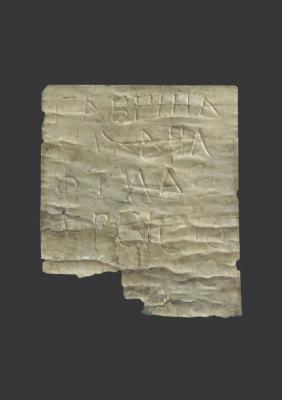 Deultum - A recent discovery at the National Archaeological Reserve and ancient Roman colony Deultum near the village of Debelt in Sredets municipality is believed to be the earliest indication of Christianity in Bulgarian lands, according to BTA reports. Unearthed during summer excavations in 2023, a silver amulet has garnered attention for its significance. The amulet was discovered in a burial site alongside the deceased's head. Initially thought to be a silver ingot, it was later revealed to be an amulet inscribed with the names of archangels Gabriel and Michael, along with the Guardian Christ, Todorova explained that the term "Guardian" (ΦΥΛΑΞ) denotes both Christ's role and the amulet's purpose of protecting its wearer. Early Christians often concealed their faith, hence Christ's representation with various symbols. In this instance, the amulet was buried with the deceased, suggesting secrecy, with Christ's name inscribed in a manner forming a cross, a common feature in early Christian inscriptions. The interpretation and dating of the amulet were conducted by renowned epigrapher Ch. Assistant Dr. Nikolay Sharankov, in collaboration with the reserve's team for reading and publishing inscriptions unearthed during excavations. According to Krasimira Kostova, director of the National Archaeological Reserve "Deultum" - Debelt, the artifact dates back to the late second or early third century AD, marking a significant milestone in the region's Christian history. In his analysis featured in the specialized publication Arheologia Bulgarica, Dr. Sharankov presents a compelling argument for dating the inscription as +ΡЄICTOC with ЄI instead of I. He posits that the inclusion of the cross and the naming of only Archangels Gabriel and Michael strongly suggest the amulet's connection to a Christian community. Moreover, Sharankov asserts that its dating establishes it as the oldest Christian artifact in Bulgaria, marking the earliest mention of Christ in the region.
Deultum - A recent discovery at the National Archaeological Reserve and ancient Roman colony Deultum near the village of Debelt in Sredets municipality is believed to be the earliest indication of Christianity in Bulgarian lands, according to BTA reports. Unearthed during summer excavations in 2023, a silver amulet has garnered attention for its significance. The amulet was discovered in a burial site alongside the deceased's head. Initially thought to be a silver ingot, it was later revealed to be an amulet inscribed with the names of archangels Gabriel and Michael, along with the Guardian Christ, Todorova explained that the term "Guardian" (ΦΥΛΑΞ) denotes both Christ's role and the amulet's purpose of protecting its wearer. Early Christians often concealed their faith, hence Christ's representation with various symbols. In this instance, the amulet was buried with the deceased, suggesting secrecy, with Christ's name inscribed in a manner forming a cross, a common feature in early Christian inscriptions. The interpretation and dating of the amulet were conducted by renowned epigrapher Ch. Assistant Dr. Nikolay Sharankov, in collaboration with the reserve's team for reading and publishing inscriptions unearthed during excavations. According to Krasimira Kostova, director of the National Archaeological Reserve "Deultum" - Debelt, the artifact dates back to the late second or early third century AD, marking a significant milestone in the region's Christian history. In his analysis featured in the specialized publication Arheologia Bulgarica, Dr. Sharankov presents a compelling argument for dating the inscription as +ΡЄICTOC with ЄI instead of I. He posits that the inclusion of the cross and the naming of only Archangels Gabriel and Michael strongly suggest the amulet's connection to a Christian community. Moreover, Sharankov asserts that its dating establishes it as the oldest Christian artifact in Bulgaria, marking the earliest mention of Christ in the region.
EGYPTE – 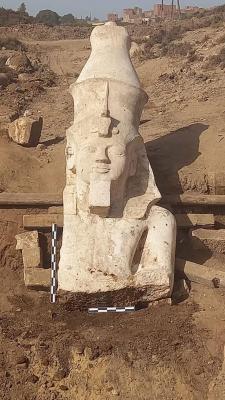 Minya - large section from the upper part of a colossal statue of Ramesses II, who ruled from 1279 to 1213 B.C. during the 19th Dynasty, has been uncovered by a joint Egyptian-American archaeological team working near the city of Minya in Upper Egypt, according to a Reuters report. Egyptian archaeologist Bassem Jihad said that the carved piece of limestone, which measures about 12.5 feet tall, shows Ramesses wearing a double crown and a headdress topped with a royal cobra. A text written in hieroglyphics on the upper area of the back of the statue glorifies the king, he added. The lower section of the statue was discovered by German archaeologist Gunther Roeder in 1930. Originally, the entire statue would have stood more than 20 feet tall. Mustafa Waziri of Egypt’s Supreme Council of Antiquities said that the researchers will create a model of what the statue would have looked like in antiquity.
Minya - large section from the upper part of a colossal statue of Ramesses II, who ruled from 1279 to 1213 B.C. during the 19th Dynasty, has been uncovered by a joint Egyptian-American archaeological team working near the city of Minya in Upper Egypt, according to a Reuters report. Egyptian archaeologist Bassem Jihad said that the carved piece of limestone, which measures about 12.5 feet tall, shows Ramesses wearing a double crown and a headdress topped with a royal cobra. A text written in hieroglyphics on the upper area of the back of the statue glorifies the king, he added. The lower section of the statue was discovered by German archaeologist Gunther Roeder in 1930. Originally, the entire statue would have stood more than 20 feet tall. Mustafa Waziri of Egypt’s Supreme Council of Antiquities said that the researchers will create a model of what the statue would have looked like in antiquity.
https://www.archaeology.org/news/12194-240305-egypt-ramesses-statue
ESPAGNE – 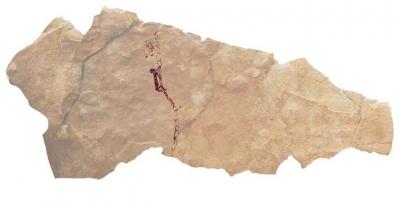 Barranco Gómez - At the site of Barranco Gómez in eastern Spain, a team led by archaeologist Inés Domingo of the University of Barcelona recently discovered a 9,000-year-old Neolithic rock art depiction of a high-flying honey hunter. The panel, made in what scholars call the Levantine rock art tradition, shows a person with seemingly no fear of heights using a 25-foot-tall rope ladder attached to a cliff in pursuit of a large beehive. The artist painted the scene realistically, depicting individual loops of the ladder compressing under the climber’s weight. “We were impressed by the precise execution of the scene and the realism of the action depicted,” says Domingo. “The details of the type of ladder used and the safety measures implemented to secure the rope to the wall are truly exceptional.” She adds that the fidelity of the Levantine rock art tradition gives scholars the chance to tease out details of ancient life previously invisible to archaeologists.
Barranco Gómez - At the site of Barranco Gómez in eastern Spain, a team led by archaeologist Inés Domingo of the University of Barcelona recently discovered a 9,000-year-old Neolithic rock art depiction of a high-flying honey hunter. The panel, made in what scholars call the Levantine rock art tradition, shows a person with seemingly no fear of heights using a 25-foot-tall rope ladder attached to a cliff in pursuit of a large beehive. The artist painted the scene realistically, depicting individual loops of the ladder compressing under the climber’s weight. “We were impressed by the precise execution of the scene and the realism of the action depicted,” says Domingo. “The details of the type of ladder used and the safety measures implemented to secure the rope to the wall are truly exceptional.” She adds that the fidelity of the Levantine rock art tradition gives scholars the chance to tease out details of ancient life previously invisible to archaeologists.
https://www.archaeology.org/issues/544-2403/digs/12127-dd-spain-neolithic-honey-hunters
BOLIVIE – 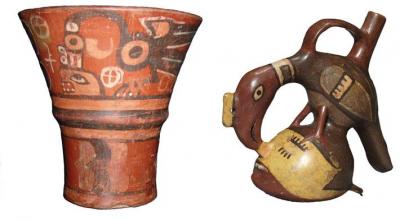 Tiwanaku - People belonging to several different Andean societies lived in and around the city of Tiwanaku near Bolivia’s Lake Titicaca from around A.D. 590 to 1150. Tiwanaku was the most important political and religious Andean center of its era. Its ritual precincts featured intricately worked megalithic structures and massive stone carvings, many of which depict mythological beasts that scholars refer to as “sacrificers” and “decapitators.” Some of these motifs, such as those known as Decapitator Deer and Monstrous Bird, represent fantastic animals using weapons to behead humans.;Archaeologist David Trigo Rodríguez of the Higher University of San Simón and researcher Roberto Carlos Hidalgo of Simón Bolívar Andean University recently studied a related, but overlooked, Tiwanaku motif that appears on tablets used to consume snuff as well as on ritual cups known as keros that contained chicha, or corn beer. This motif, which is found on objects unearthed outside the city, features a realistic depiction of a condor scavenging human or animal corpses. Rodríguez and Hidalgo have dubbed the bird the Tiwanaku Condor Devourer. “We suggest the theme of the Tiwanaku Condor Devourer was related to rites of rural societies,” says Rodríguez. Perhaps, he adds, people living in Tiwanaku’s hinterland frequently observed condors eating carrion and chose to incorporate naturalistic depictions of the fearsome bird into their rituals in ways residents of the city did not.
Tiwanaku - People belonging to several different Andean societies lived in and around the city of Tiwanaku near Bolivia’s Lake Titicaca from around A.D. 590 to 1150. Tiwanaku was the most important political and religious Andean center of its era. Its ritual precincts featured intricately worked megalithic structures and massive stone carvings, many of which depict mythological beasts that scholars refer to as “sacrificers” and “decapitators.” Some of these motifs, such as those known as Decapitator Deer and Monstrous Bird, represent fantastic animals using weapons to behead humans.;Archaeologist David Trigo Rodríguez of the Higher University of San Simón and researcher Roberto Carlos Hidalgo of Simón Bolívar Andean University recently studied a related, but overlooked, Tiwanaku motif that appears on tablets used to consume snuff as well as on ritual cups known as keros that contained chicha, or corn beer. This motif, which is found on objects unearthed outside the city, features a realistic depiction of a condor scavenging human or animal corpses. Rodríguez and Hidalgo have dubbed the bird the Tiwanaku Condor Devourer. “We suggest the theme of the Tiwanaku Condor Devourer was related to rites of rural societies,” says Rodríguez. Perhaps, he adds, people living in Tiwanaku’s hinterland frequently observed condors eating carrion and chose to incorporate naturalistic depictions of the fearsome bird into their rituals in ways residents of the city did not.
https://www.archaeology.org/issues/544-2403/digs/12132-dd-bolivia-tiwanaku-condor-devourer
TURQUIE –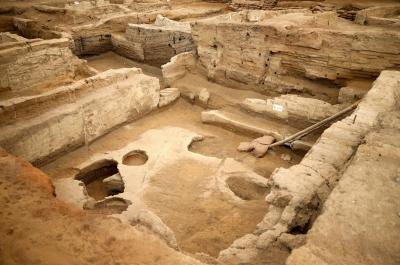 Çatalhöyük - Archaeologists uncovered an 8,600-year-old piece of bread in what resembled an oven in the ancient settlement of Çatalhöyük Located in the Cumra district of Konya, Çatalhöyük, where approximately 8,000 people lived together during the Neolithic period, a structure resembling an oven was discovered in an area known as "Space 66," characterized by adobe houses with interconnected roofs accessed from above. Near the severely damaged oven, a palm-sized artifact was found containing wheat, barley, and pea seeds, likely used for food. Analyses conducted at the Science and Technology Research and Application Center (BITAM) of Necmettin Erbakan University in Konya revealed that the spongy residue identified as leavened bread dates back to 6,600 B.C.
Çatalhöyük - Archaeologists uncovered an 8,600-year-old piece of bread in what resembled an oven in the ancient settlement of Çatalhöyük Located in the Cumra district of Konya, Çatalhöyük, where approximately 8,000 people lived together during the Neolithic period, a structure resembling an oven was discovered in an area known as "Space 66," characterized by adobe houses with interconnected roofs accessed from above. Near the severely damaged oven, a palm-sized artifact was found containing wheat, barley, and pea seeds, likely used for food. Analyses conducted at the Science and Technology Research and Application Center (BITAM) of Necmettin Erbakan University in Konya revealed that the spongy residue identified as leavened bread dates back to 6,600 B.C.
SUISSE – 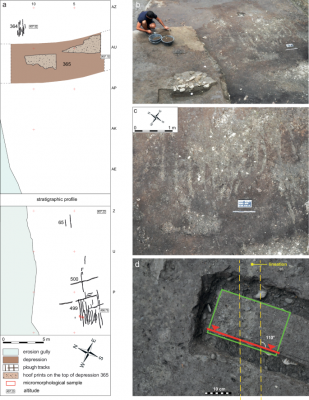 Sion - For the past four decades, the ‘Secondary Products Revolution’ model, i.e., the exploitation of animal resources that do not involve killing the animal, such as the production of milk and wool and the use of animals for physical labour has been the object of heated discussion between Neolithic scholars. According to this model, the use of animal strength arrived relatively late in Europe—during the socio-economic changes of the Late Neolithic in the 4th millennium BCE. Plough marks are the most convincing direct evidence of the use of animal traction. However, few are preserved making them relatively rare throughout Europe and dating them is difficult and often imprecise. Recent research at the Anciens Arsenaux site in Sion, Valais, Switzerland has revealed the presence of the oldest known plough marks in Europe, dating from the beginning of the 5th millennium BCE. They bear witness to the use of animal traction quite soon after the establishment of an agro-pastoral economy in the Alpine region. This is corroborated by recent archaeozoological studies and suggests that this important innovation could already be part of the Neolithic package introduced into Europe during the 6th millennium BCE.
Sion - For the past four decades, the ‘Secondary Products Revolution’ model, i.e., the exploitation of animal resources that do not involve killing the animal, such as the production of milk and wool and the use of animals for physical labour has been the object of heated discussion between Neolithic scholars. According to this model, the use of animal strength arrived relatively late in Europe—during the socio-economic changes of the Late Neolithic in the 4th millennium BCE. Plough marks are the most convincing direct evidence of the use of animal traction. However, few are preserved making them relatively rare throughout Europe and dating them is difficult and often imprecise. Recent research at the Anciens Arsenaux site in Sion, Valais, Switzerland has revealed the presence of the oldest known plough marks in Europe, dating from the beginning of the 5th millennium BCE. They bear witness to the use of animal traction quite soon after the establishment of an agro-pastoral economy in the Alpine region. This is corroborated by recent archaeozoological studies and suggests that this important innovation could already be part of the Neolithic package introduced into Europe during the 6th millennium BCE.
https://www.nature.com/articles/s41599-024-02837-5
ARGENTINE – 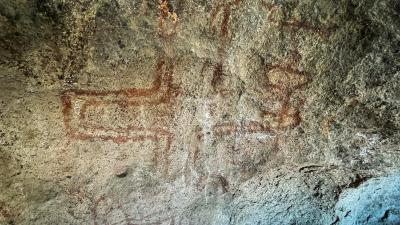 Huenul 1 cave - Archaeologists have discovered the earliest dated cave paintings in South America in Argentine Patagonia, dating back 8,200 years. The 895 paintings were found by Argentine and Chilean archaeologists in the Huenul 1 cave, a 630 square meter rock shelter located in the province of Neuquen, some 1,100 kilometers (684 miles) southwest of the capital Buenos Aires. "We were able to date four black peniform patterns that were drawn in charcoal. These proved to be the earliest direct dating of cave paintings in South America," said Dr. Guadalupe Romero Villanueva, author of the research published in the Science Advances journal. The Argentinean archaeologist said the discovery indicates that the production of cave art began in the Huenul cave about 8,000 years ago and that the practice of painting the particular pattern seen in the cave was sustained for a period of at least 3,000 years. The discovery provides evidence of the artistic ability and cultural transmission of the hunter-gatherer societies which inhabited the region during the middle Holocene, a period roughly from 7,000 to 5,000 years ago, and reveals the socioecological resilience to climate, as well as serving as a means of communication between scattered populations. "We believe these images in particular were part of a resilient response of the mobile hunter-gatherer groups that occupied this cave and the desert environments of northern Patagonia to the climatic challenge of a period of extreme dryness that occurred during the middle Holocene," said Romero Villanueva, a researcher at the National Council for Scientific and Technical Research of Argentina. Villanueva said there are other places in South America that could have older cave paintings, but which only have relative dating, like Argentina's Cueva de las Manos, with cave paintings dating back 9,500 years.
Huenul 1 cave - Archaeologists have discovered the earliest dated cave paintings in South America in Argentine Patagonia, dating back 8,200 years. The 895 paintings were found by Argentine and Chilean archaeologists in the Huenul 1 cave, a 630 square meter rock shelter located in the province of Neuquen, some 1,100 kilometers (684 miles) southwest of the capital Buenos Aires. "We were able to date four black peniform patterns that were drawn in charcoal. These proved to be the earliest direct dating of cave paintings in South America," said Dr. Guadalupe Romero Villanueva, author of the research published in the Science Advances journal. The Argentinean archaeologist said the discovery indicates that the production of cave art began in the Huenul cave about 8,000 years ago and that the practice of painting the particular pattern seen in the cave was sustained for a period of at least 3,000 years. The discovery provides evidence of the artistic ability and cultural transmission of the hunter-gatherer societies which inhabited the region during the middle Holocene, a period roughly from 7,000 to 5,000 years ago, and reveals the socioecological resilience to climate, as well as serving as a means of communication between scattered populations. "We believe these images in particular were part of a resilient response of the mobile hunter-gatherer groups that occupied this cave and the desert environments of northern Patagonia to the climatic challenge of a period of extreme dryness that occurred during the middle Holocene," said Romero Villanueva, a researcher at the National Council for Scientific and Technical Research of Argentina. Villanueva said there are other places in South America that could have older cave paintings, but which only have relative dating, like Argentina's Cueva de las Manos, with cave paintings dating back 9,500 years.
ALLEMAGNE – 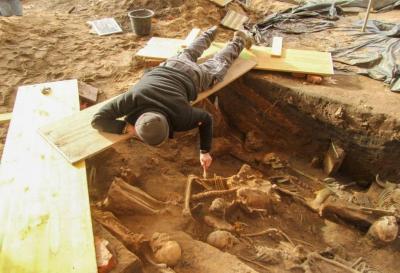 Nuremberg - Archaeologists say they have discovered in the south of Germany, perhaps the largest mass grave ever found in Europe. About 1,000 skeletons of plague victims were found in a mass grave in the center of Nuremberg, where, according to experts, there may be a total of more than 1,500 people. According to Melanie Langbein from the Nuremberg Department of Heritage Conservation, eight pits were discovered, each containing several hundred bodies. "These people were not buried in an ordinary cemetery. A large number of the dead had to be buried in a short time, regardless of the Christian burial practice. It is more than likely that the plague is the cause of mass graves," Langbein said. Since the 14th century, outbreaks of plague have occurred in Nuremberg approximately every 10 years, which made it difficult to date the remains. According to Langbein, a note from 1634 was also discovered, which describes in detail the outbreak of the plague that killed more than 15,000 people in 1632-1633. It says that almost two thousand people were buried near St. Sebastian's Hospital, the site of the current excavations. Archaeologists expect the number of remains to reach two thousand or even more, making this cemetery the largest mass grave in Europe.
Nuremberg - Archaeologists say they have discovered in the south of Germany, perhaps the largest mass grave ever found in Europe. About 1,000 skeletons of plague victims were found in a mass grave in the center of Nuremberg, where, according to experts, there may be a total of more than 1,500 people. According to Melanie Langbein from the Nuremberg Department of Heritage Conservation, eight pits were discovered, each containing several hundred bodies. "These people were not buried in an ordinary cemetery. A large number of the dead had to be buried in a short time, regardless of the Christian burial practice. It is more than likely that the plague is the cause of mass graves," Langbein said. Since the 14th century, outbreaks of plague have occurred in Nuremberg approximately every 10 years, which made it difficult to date the remains. According to Langbein, a note from 1634 was also discovered, which describes in detail the outbreak of the plague that killed more than 15,000 people in 1632-1633. It says that almost two thousand people were buried near St. Sebastian's Hospital, the site of the current excavations. Archaeologists expect the number of remains to reach two thousand or even more, making this cemetery the largest mass grave in Europe.
https://www.azernews.az/region/222918.html
ANGLETERRE – 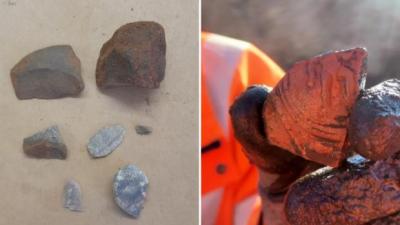 Penrith - An archaeological dig, part of the A66 Northern Trans-Pennine Project, may have unearthed evidence dating back to Cumbria's first farmers. Oxford Cotswold Archaeology (OCA) has been at the site between Penrith and Scotch Corner since late November, ahead of National Highways' £1.3 billion project to convert parts of the A66 into a dual carriageway. So far, stone tools, pottery shards and Roman relics have been uncovered as part of the project. Fragments of pottery and Samian ware (Roman china) unearthed give evidence of daily life in the region, as well as when the site would have been used by the Romans as a road. "Clearly, the area around Penrith where we are currently working was once part of a very extensive trade network that stretched to intercontinental Europe.
Penrith - An archaeological dig, part of the A66 Northern Trans-Pennine Project, may have unearthed evidence dating back to Cumbria's first farmers. Oxford Cotswold Archaeology (OCA) has been at the site between Penrith and Scotch Corner since late November, ahead of National Highways' £1.3 billion project to convert parts of the A66 into a dual carriageway. So far, stone tools, pottery shards and Roman relics have been uncovered as part of the project. Fragments of pottery and Samian ware (Roman china) unearthed give evidence of daily life in the region, as well as when the site would have been used by the Romans as a road. "Clearly, the area around Penrith where we are currently working was once part of a very extensive trade network that stretched to intercontinental Europe.
https://www.newsandstar.co.uk/news/24167638.archaeological-dig-a66-unearths-treasures/
PANAMA – 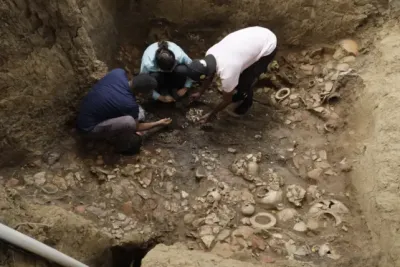
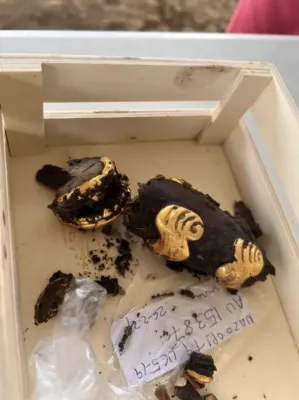 El Caño - In the ancient Coclé culture, which existed in Panama between 200 BCE and 1550 CE, elite individuals didn't have to worry about eternal solitude. The tomb of a young Coclé lord from roughly 1,200 years ago reveals the spine-chilling reality for any surrounding company when a powerful leader dies. In a specific section of the Rio Grande Valley, archaeological evidence from ancient cemeteries suggests that Coclé chiefs and nobility were sometimes buried alongside their companions, such as their favorite wives or servants, who were sacrificed as part of the funeral. The tomb of the Coclé lord, which was originally found in 2011 in El Caño Archaeological Park, contains piles of gold artifacts and the bones of up to 31 other people. The elite individual's own body was interred face down on top of a female body, which experts say was a common tradition in the culture. Over the years, archaeologists unearthing the ancient enclosed cemeteries of El Caño and a nearby spot called Sitio Conte have found numerous tombs that hold more than one body. But the burial of the young lord in El Caño around 750 CE is especially lavish. The luxury items found in his tomb probably had spiritual significance. Among shards and shards of pottery lie two belts made of gold beads, four bracelets, two earrings in the shape of a man and a woman, an earring in the shape of a crocodile, a beaded necklace, five earrings made from sperm whale teeth with gold covers, two gold plates, two bells, skirts and bracelets made of dog teeth, and a set of flutes made from bone. The excavation of the site is not yet complete, which means the numbers of individuals buried in that one single tomb could still change. The range sits somewhere between 8 and 32, but it's hard to say for sure which bones go with which person without genetic analysis.
El Caño - In the ancient Coclé culture, which existed in Panama between 200 BCE and 1550 CE, elite individuals didn't have to worry about eternal solitude. The tomb of a young Coclé lord from roughly 1,200 years ago reveals the spine-chilling reality for any surrounding company when a powerful leader dies. In a specific section of the Rio Grande Valley, archaeological evidence from ancient cemeteries suggests that Coclé chiefs and nobility were sometimes buried alongside their companions, such as their favorite wives or servants, who were sacrificed as part of the funeral. The tomb of the Coclé lord, which was originally found in 2011 in El Caño Archaeological Park, contains piles of gold artifacts and the bones of up to 31 other people. The elite individual's own body was interred face down on top of a female body, which experts say was a common tradition in the culture. Over the years, archaeologists unearthing the ancient enclosed cemeteries of El Caño and a nearby spot called Sitio Conte have found numerous tombs that hold more than one body. But the burial of the young lord in El Caño around 750 CE is especially lavish. The luxury items found in his tomb probably had spiritual significance. Among shards and shards of pottery lie two belts made of gold beads, four bracelets, two earrings in the shape of a man and a woman, an earring in the shape of a crocodile, a beaded necklace, five earrings made from sperm whale teeth with gold covers, two gold plates, two bells, skirts and bracelets made of dog teeth, and a set of flutes made from bone. The excavation of the site is not yet complete, which means the numbers of individuals buried in that one single tomb could still change. The range sits somewhere between 8 and 32, but it's hard to say for sure which bones go with which person without genetic analysis.
https://www.sciencealert.com/lavish-tomb-reveals-spine-chilling-ritual-of-ancient-cocl-culture
KYRGYSTAN – 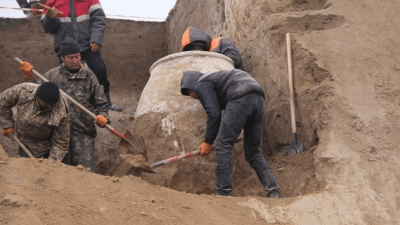 Uzgen - During recent archaeological excavations in the town of Uzgen in the Osh province of Kyrgyzstan, a 1.75-meter-high clay vessel known as a ‘hum’ was unearthed. The ancient settlement of Uzgen is the center of the oasis rich of monuments of settled and nomadic people, dating in a wide chronological range. It belongs to a zone of early contacts on the Silk Road, being the most eastern city center of Davan, as the city of Ju-Chen known on Chinese sources is traditionally localized here in the context of military expeditions of 104-99 BC. The main period of development is IV-I centuries BC. However, the town flourished under the rule of the Qarakhanid state in the 10th century AD. It was one of the capitals of the Karakhanids, who called it Mavarannahr and left three well-preserved mausolea. The excavations, led by Mars Boranbaev, had begun 10 days ago when on March 1 a ‘Hum’ was discovered 2.5 meters below ground level. The artifact, believed to have been built between the 7th and 4th centuries BC, was carefully removed unharmed and transferred to the Uzgen Museum of Architecture and Archaeology. “After meticulous cleaning, the ‘hum’ now awaits further examination as part of our ongoing research endeavors,” Abdyrahmanov elaborated. “Already, fragments of clay pottery indicative of the Shoro-Bashat culture have been unearthed, signaling the rich historical tapestry of the region.” By the end of the Bronze and Early Iron Ages, began to form, Shorobashat culture in the Ferghana Valley. The era of the Late Bronze and the Early Iron Age in the Fergana Valley parallel there were nomadic (Kairakkum and Eilatan, 11th-3rd century BC) and sedental (Chust and Shorobashat, 14th-1st centuries BC) cultures. Shorobashat culture is a sedentary agricultural culture. The excavation site is located close to the Kyzyl-Oktiabr area, where plans are in the works for a bypass road. It has great historical potential. Abdyrahmanov noted that increased archaeological research has been conducted in the hopes of finding more ancient artifacts because of the busy activity around the old city. The ‘hum,’ towering at 1.75 meters in height and spanning 1.30 meters in width, serves as a testament to the ancient civilizations that once thrived in these lands.
Uzgen - During recent archaeological excavations in the town of Uzgen in the Osh province of Kyrgyzstan, a 1.75-meter-high clay vessel known as a ‘hum’ was unearthed. The ancient settlement of Uzgen is the center of the oasis rich of monuments of settled and nomadic people, dating in a wide chronological range. It belongs to a zone of early contacts on the Silk Road, being the most eastern city center of Davan, as the city of Ju-Chen known on Chinese sources is traditionally localized here in the context of military expeditions of 104-99 BC. The main period of development is IV-I centuries BC. However, the town flourished under the rule of the Qarakhanid state in the 10th century AD. It was one of the capitals of the Karakhanids, who called it Mavarannahr and left three well-preserved mausolea. The excavations, led by Mars Boranbaev, had begun 10 days ago when on March 1 a ‘Hum’ was discovered 2.5 meters below ground level. The artifact, believed to have been built between the 7th and 4th centuries BC, was carefully removed unharmed and transferred to the Uzgen Museum of Architecture and Archaeology. “After meticulous cleaning, the ‘hum’ now awaits further examination as part of our ongoing research endeavors,” Abdyrahmanov elaborated. “Already, fragments of clay pottery indicative of the Shoro-Bashat culture have been unearthed, signaling the rich historical tapestry of the region.” By the end of the Bronze and Early Iron Ages, began to form, Shorobashat culture in the Ferghana Valley. The era of the Late Bronze and the Early Iron Age in the Fergana Valley parallel there were nomadic (Kairakkum and Eilatan, 11th-3rd century BC) and sedental (Chust and Shorobashat, 14th-1st centuries BC) cultures. Shorobashat culture is a sedentary agricultural culture. The excavation site is located close to the Kyzyl-Oktiabr area, where plans are in the works for a bypass road. It has great historical potential. Abdyrahmanov noted that increased archaeological research has been conducted in the hopes of finding more ancient artifacts because of the busy activity around the old city. The ‘hum,’ towering at 1.75 meters in height and spanning 1.30 meters in width, serves as a testament to the ancient civilizations that once thrived in these lands.
https://arkeonews.net/an-ancient-large-clay-vessel-hum-1-75-meters-high-unearthed-in-kyrgyzstan/